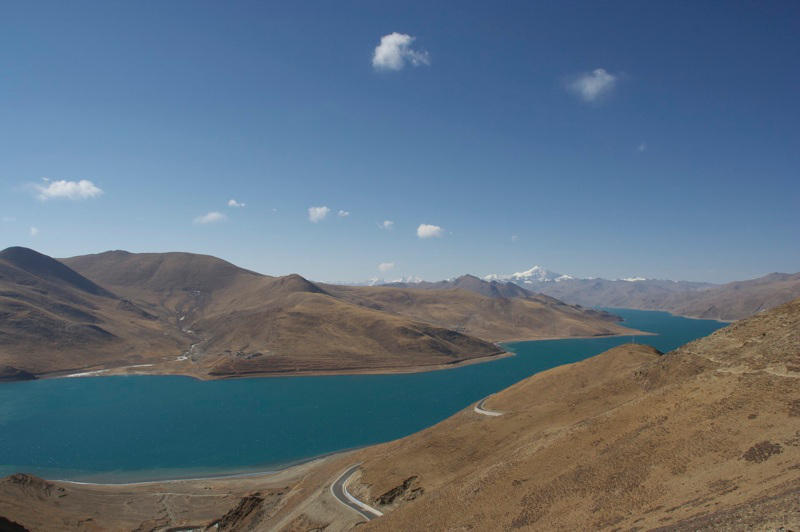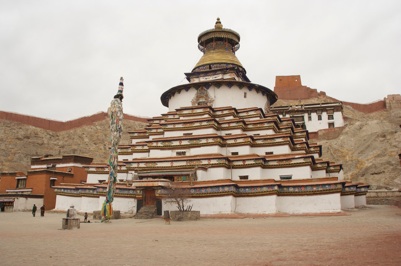 The chinese girl brought a korean guy, Yoon-Ki, so we ended up with a decent price when we were five people, about 65 € for me with a return to Lhasa in four days. Not bad at all. So off we went.
The chinese girl brought a korean guy, Yoon-Ki, so we ended up with a decent price when we were five people, about 65 € for me with a return to Lhasa in four days. Not bad at all. So off we went.
We passed a long military guarded bridge and just after it we stopped to look at the scenery as well as a burial site. The water flowing here was a river that flows down to all other rivers in Tibet (sounds close to a myth to me though) and this was a place for one of the two different burial rituals the tibetan have. The rituals are called water and heavenly/sky burial. Both parts have in common that the body is carried to the burial site by a close friend and then chopped up to pieces. Then either the pieces are thrown into the water or left for vultures. The favorite food of the deceased is put forth and a wooden stick with a colorful prayer flag is attached to any existing sticks. Each year the monks remove all the wooden sticks so the count for the burial site begins from zero again. Also all pictures of the deceased must be destroyed, for the person to move on to their next life. Holy persons can have their pictures left though.
Both parts have in common that the body is carried to the burial site by a close friend and then chopped up to pieces. Then either the pieces are thrown into the water or left for vultures. The favorite food of the deceased is put forth and a wooden stick with a colorful prayer flag is attached to any existing sticks. Each year the monks remove all the wooden sticks so the count for the burial site begins from zero again. Also all pictures of the deceased must be destroyed, for the person to move on to their next life. Holy persons can have their pictures left though.
As we continue to drive there are sheep, yaks and cows crossing the road. The population of the small villages or scattered houses all make their living on crops or animal husbandry.
After a long coiling road up on the mountains we reach Yamdrok-Tso, another of the four holy lakes in Tibet. This one at the altitude of 4488 meters and popular for pilgrims to walk around clockwise (this taking about a week though). Again, wonderful colors of the water and with a mountain peak of 7191 meters, Nojin Kangtsang, as a backdrop. The lake is considered holy to the extent that anyone caught swimming in the lake would be killed by the locals. The temperature didn’t tempt me although I can see that it would be nice in the summer. The lake is a dead lake, with no water coming either in or out. The huge mass of water on this altitude proved to be too much of a temptation for the chinese government who installed pumps to electrify Lhasa. This was not unexpectedly disliked by the tibetans and protests have halted the work once but now it’s up and running, slowly draining the lake. Environmental scientists claim that the lake may be drained in 20 years, the chinese government however claim that excess power is used to pump back water (?). I guess future will tell.
The lake is a dead lake, with no water coming either in or out. The huge mass of water on this altitude proved to be too much of a temptation for the chinese government who installed pumps to electrify Lhasa. This was not unexpectedly disliked by the tibetans and protests have halted the work once but now it’s up and running, slowly draining the lake. Environmental scientists claim that the lake may be drained in 20 years, the chinese government however claim that excess power is used to pump back water (?). I guess future will tell.
We drove away from the beauty and stopped in Nagartse for a quick meal and then heading on towards Gyantse. Gyantse has a monastery (surprise!) which is rather famous, Gyantse Kumbum. Kumbum means 100 000 and should number the amount of images in the temple. To a layman like myself they seemed rather similar though, but I guess it still counts. When leaving I heard the same song I’d bought from a vcd vendor and commented on this. The driver, Jue-a, thought this was very funny since it was his cousin who was the artist. I guess Tibet is a rather small place after all. The song was apparently a big hit in Tibet.
When leaving I heard the same song I’d bought from a vcd vendor and commented on this. The driver, Jue-a, thought this was very funny since it was his cousin who was the artist. I guess Tibet is a rather small place after all. The song was apparently a big hit in Tibet.
When we finally arrived in Shigatse, the Tashilunpho monastery was closed so we instead went to first open restaurant. Which proved to be easier said than done, it seemed like they close this city at sunset. At last we found a warm cosy place who had two sorts of dishes, noodles and noodles. We ordered everything from their menu but could not tell the difference, not saying that the noodles was bad though.
It was time to sleep in the rather cold hostel now, the guys shared one room and the ladies another. The concept of warm water was a mere fantasy but then again, I guess you get used to washing with ice cold water as everything else.

You must be logged in to post a comment.